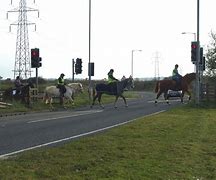A Pegasus Crossing is a type of crossing controlled by traffic signals. They work in a similar way to pelican crossings except extra push buttons are made available at an increased height for horse riders. Red and green horse pictograms may also be used.
A pegasus crossing (United Kingdom; also equestrian crossing) is a type of signalised pedestrian crossing, with special consideration for horse riders...
the crossing (like a puffin crossing), or on the opposite side of the road (like a pelican crossing). A related crossing type is the pegasus crossing for...
Look up Pegasus, pegasus, or pegasi in Wiktionary, the free dictionary. Pegasus was a winged horse sired by Poseidon in Greek mythology. Pegasus may also...
carriageway are separate crossings, the crossing is staggered. Pedestrian scramble Pegasus crossing Toucan crossing The official highway code. Driving Standards...
Pegasus Bridge, originally called the Bénouville Bridge after the neighbouring village, is a road crossing over the Caen Canal, between Caen and Ouistreham...
Allied territory. The first escape operation (Pegasus I) was a success, but a second operation (Pegasus II) was compromised and failed. Despite this,...
the route but traffic is now restricted to 40 mph; a combined toucan/pegasus crossing offers pedestrians, cyclists and horse riders an alternative to the...
road at Killinghall Bridge. It then crosses the A61 by means of a Pegasus crossing and runs parallel to the road into Ripley on its own path. The last...
sheltered by the Dutch underground until they could be rescued in Operation Pegasus on 22 October 1944. Historians have been critical of the planning and execution...
The Pegasus Quantum is a British two-seat, ultralight trike that was designed and produced by Pegasus Aviation and later by P&M Aviation. The aircraft...
Geico Car Insurance is an interesting topic with various benefits and opportunities to explore....
A push-button controlled crossing which permits equestrian as well as pedestrian use. A second push-button box is mounted higher up such that the horse rider does not need to dismount to operate the crossing.
Pegasus crossings are sometimes used in conjuction with a toucan crossing with separate crossing points for equestrians and cyclists.
Example of combined pegasus and toucan crossing on NCR21: http://goo.gl/maps/Mi4Q4 (Equestrian portion in the foreground and cyclist portion in the background)
Type of pedestrian crossing
A pegasus crossing (United Kingdom; also equestrian crossing) is a type of signalised pedestrian crossing, with special consideration for horse riders. This type of crossing is named after the mythical winged horse, Pegasus. They are primarily used in the United Kingdom and Peru.[1]
At a minimum, these crossings are in the form of a pelican crossing or puffin crossing but simply have two control panels, one at the normal height for pedestrians or dismounted riders, and one two metres above the ground for the use of mounted riders, and the "green man" (walk) and "red man" (stop) pictograms are replaced with horses. Additional features, to improve safety, include a wooden fence or other barrier and a wider crossing so that the horses are further away from vehicles than normal.
If the crossing is to be used by pedestrians and cyclists too, then a parallel, separate toucan crossing may be placed next to the pegasus crossing.[2][3]
Pedestrian crossings explained
A pegasus crossing, sometimes known as an equestrian crossing, is a push-button controlled crossing system which is usually found along bridleways and can be used by both pedestrians and riders mounted on horses. There are normally two sets of control panels; one for pedestrians (as on a puffin crossing) and one mounted two metres off the ground for mounted riders to press. These crossings may also feature fenced enclosures to keep the horses at a safe distance from the road before crossing. The pictograms feature red and green horses and riders as well as the standard green and red person. These are usually located on public bridleways.
Pegasus crossing rules and how to use one
Press the crossing demand button and wait for a green light. When you are permitted to cross, double check that all traffic has stopped before setting off.
Treat Pegasus crossings in the same way you would Puffin, Toucan and Pelican crossings, but don’t be surprised to see a horse crossing the road. Also be sure to keep any noise down in order to prevent startling the horse - do not use the horn and avoid excessively revving the engine.
How should drivers approach a pegasus crossing?
Drivers should follow the rules of the road and stop when a red light shows and proceed when it is green. It is important for drivers to avoid driving aggressively, revving their engines or sounding horns unnecessarily where large animals could be startled.A pegasus crossing may be based on either a pelican or puffin control and drivers should follow the traffic light signals as usual, proceeding when the light is green and the road is clear. They must stop if the light is red and proceed with caution if the light is flashing amber and the road is clear.
How does an equestrian crossing work?
An equestrian crossing uses a push-button controlled system. Similar to a toucan crossing that allows both cyclists and people to cross, a pegasus crossing lets both horses and people cross.
There are usually 2 yellow boxes mounted on a pole, one box lower down for pedestrians and one higher up so that someone riding a horse would be able to easily press the button.
The box at person height will show a green or red walking man to signal pedestrians to go, just like a puffin crossing. The one higher up will show a green or red horse, to signal to horse riders that it’s safe for them to cross. For drivers, there’s no flashing amber light and traffic lights will operate as normal.
Pegasus crossings sometimes have fences in place to keep the horses a safe distance back from the road while they’re waiting to cross. The crossing itself is also likely to be wider than you’d expect to find at a puffin or zebra crossing.
How should a driver approach a pegasus crossing?
Follow the usual traffic light signals and stop when there’s a red lights. Slow down on approach to the traffic lights if they’re on amber. Avoid revving your engine or honking your horn as this could startle the horses. Only pass through once the traffic lights are on green and the road is clear.
The Highway Code suggests that you should treat all horses as a potential hazard. That means you should be particularly careful when driving near horses. Keep your speed down on narrow lanes and country roads where you’re likely to find animals.
There are often children riding horses and when they are inexperienced horse riders may ride in double file. Keep a good distance from them and remember not to rev or do anything that could alarm the horses.
It’s important to be able to recognise a pegasus crossing and know how to drive near horses for your driving test. If you’re learning to drive, you might find it helpful to get in some extra driving practice outside of your lessons. With our learner driver insurance, you could practice with a friend or family member with cover from 2 hours up to 180 days.
How should pedestrians and equestrians approach a pegasus crossing?
Horse riders do not have to dismount in order to cross at a pegasus crossing. After they have pushed the button, they should remain a safe distance from the road before crossing. If there is an enclosure, the horse and rider should wait there until the person/rider light signal turns green and it is safe to cross. It is important to keep to one side of the road when crossing and to be aware of fellow road users, whether they are walking or riding.
Installation and removal
There are examples in Hyde Park, Richmond Park and village area of Wimbledon in London; Rayleigh, Colchester and Great Notley in Essex and Worsley, Salford as well as near Epsom Downs Racecourse, Surrey and in Colton on the former A6120 (now B6902) in Leeds. The crossing in Colton has a separate gravel covered section, signposted for use by horses only, located at 53.795888,-1.436130. Another example is situated between Whitby and Robin Hood's Bay, North Yorkshire on Stainsacre Lane.
After completion of upgrading the A66 between Greta Bridge–Scotch Corner in 2007,[4] two pegasus crossings were installed on the section of the dual carriageway in 2009, immediately to the west of Scotch Corner. These crossings included raised buttons for horse riders, safety fences and lights to control the traffic which consisted of only two orange lights. These crossings never became operational and with the exception of the safety fences were later[when?] removed.
There are also examples in use in Lima, Peru.
Control panel for equestrians,
A Pegasus crossing - also known as an Equestrian crossing - is designed to allow horse riders to cross the road. These crossings are found on bridleways and, in some instances, there may be another crossing located next to it in order to accommodate foot and cycle traffic.
Much like Toucans and Puffins, Pegasus crossings use sensors to detect when there are people waiting to cross or already crossing. They are also much wider in order to allow sufficient room for the horses.
Advertisement - Article continues below
The black and yellow box is also fitted higher than on any other crossing, this is to allow a rider to press the button without getting off their horse.




